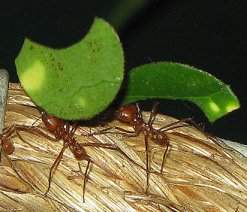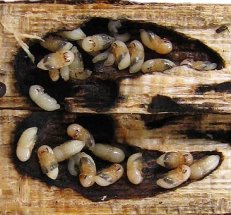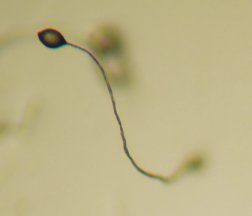My previous post dealt with symbiosis, which I consider to be the most stunning example of the design that is inherent in nature. In this post, I want to discuss a specific kind of symbiosis that scientists find in Creation: farming. While many think that farming is a uniquely human activity, nothing could be further from the truth. In fact, the more we study nature, the more it seems that farming is a consistent theme throughout the natural world. This was brought home to me recently as I read a paper in the journal Nature. Before discussing the main topic of the journal article, I want to write about the various farming animals of which I am aware.


(Click for credit)
Over 160 species of termite engage in farming a fungus. Unlike the leafcutter ants, however, the termites don’t actually eat the fungus. They grow their fungus on a compost heap, and the fungus breaks that compost heap down into a nutritious, easy-to-digest food for the termites. This relationship is so beneficial for the fungus, it has been suggested that perhaps it is not the termites who are farming the fungus, but the fungus that is conscripting the termites!3
Several species of damselfish from the genus Stegastes farm algae. An individual will “stake out” a patch of a particular red algae (genus Polysiphonia) and then tend that patch, eating only part of what grows there. It also fiercely defends that farm from any potential predators. This not only includes fish, but also divers! On two dives, I have been attacked by damselfish that thought I was trying to take their algae. It is an amazing thing, because most fish swim away from divers, but these fish came right at me, despite the enormous size difference! Studies along Japanese coral reefs indicate that this genus of red algae exists only on damselfish farms.4

The marsh periwinkle (Littoraria irrorata) can often be found clinging to cordgrass leaves. While an observer might think it is eating the leaves, that’s not what the snail is doing. It is tending its fungus farm. A snail uses its radula (a sharp tongue-like appendage) to make a wound in the leaf. This wound is the perfect place for certain intertidal fungi to grow. The snail tends this patch of fungus and uses it for food.6

Now that I am done surveying the animals that farm, I want to discuss the Nature article that prompted this post. The article reports on a slime mold that is also a farmer!7 I have already blogged about how incredibly sophisticated these supposedly “primitive” organisms are (here and here), but this discovery really drives the point home. Slime molds are also called “social amoebae,” because they can exist as either freely-living single cells or colonies of cells. The species studied in this report (Dictyostelium discoideum) feed on bacteria. When food becomes scarce, they aggregate to produce a slug-like colony that can form a fruiting body, such as what is pictured above. This fruiting body contains spores, which it releases to be scattered by the wind.
The authors find that there are two distinctly different types of individuals within this species. One type of individual forms the colony once their food supply is completely exhausted. So they eat all they can, then form the colony to disperse spores to other places where there might be bacteria. The authors called these individuals “non-farmers.”
The other type of individual is the “farmer.” These individuals would form the colony before their bacterial food supply ran out. Then, they would incorporate bacteria into their fruiting bodies. That way, when the fruiting bodies released spores, bacteria would be released as well. The bacteria would travel with the spores, so that once the spores germinated, there would be a ready food source for them!
I wanted to go through all the different examples of non-human farming that I know in order to give you an idea of just how pervasive the phenomenon of farming is throughout Creation. From vertebrates to invertebrates to slime molds, from land to leaves to sea, organisms farm other organisms from fungi to algae to bacteria. It seems that at nearly every level of Creation, we find farmers.
Evolutionists, of course, are forced to assume this happens due to “convergent evolution.” Just by random chance, totally unrelated organisms are supposed to have developed incredibly similar behaviors. Indeed, this concept gets stretched to absurd levels, especially in the case of ambrosia beetles. Despite the fact that more than 3,000 species of ambrosia beetle have nearly the same manner of farming, evolutionists are forced to assume that this manner of farming evolved independently many different times, because the hypothesis of evolution cannot incorporate that all these species had a common, farming ancestor.
Obviously, design is a much more reasonable explanation for the pervasiveness of farming throughout Creation. Farming occurs because it is beneficial not only to the farmer but also to the “crop.” The Designer understands that, and it makes sense that He would incorporate this strategy throughout his Creation as a way of stabilizing many diverse ecosystems.
REFERENCES
1. Cameron R. Currie, et al., “Ancient Tripartite Coevolution in the Attine Ant-Microbe Symbiosis,”Science, 299:386-388, 2003
Return to Text
2. Moya-Raygoza G and Nault L.R, “Obligatory mutualism between Dalbulus quinquenotatus (Homoptera: Cicadellidae) and attendant ants,”Ann. Entomol. Soc. Am., 93:929–940, 2000
Return to Text
3. J S Turner, “A superorganism’s fuzzy boundary,”Natural History, 111 (6):62-67, 2002
Return to Text
4. Hata, Hiroki and Kato, Makoto, “A novel obligate cultivation mutualism between damselfish and Polysiphonia alga,”Biology Letters, 2:592-596, 2006
Return to Text
5. Arthur V. Evans and James N. Hogue, Introduction to California Beetles, (University of California Press, 2004), 107-108
Return to Text
6. Brian R. Silliman and Steven Y. Newell, “Fungal farming in a snail,” Proceedings of the National Academy of Sciences of the United States, 100:15643–15648, 2003
Return to Text
7. Debra A. Brock, Tracy E. Douglas, David C. Queller, and Joan E. Strassmann, “Primitive agriculture in a social amoeba,” Nature, 469:394-396, 2011
Return to Text

My name is Daniel Gray and I am 14. I love science and have been taking your apologia courses the last 3 years. I have enjoyed them very much! I am currently in Potters School and taking Biology with Mrs. McMkeeman.
My question has nothing to do with the topic you wrote, but my teacher told me to ask my questions here. 🙂
I love science and learning and my youth leader asked me to give a sermon on evolution and the 6 day creation. In my research and preparation for the sermon, I came upon a theory that the sun has been shrinking 5 feet per hour. This essentially means that the sun would have been so big that the sun would have engulfed the earth 20 million years ago. I have read mixed opinions about the theory, but if it is true, it seals the tombstone for evolution and billion year creation. There is a lot of hate coming from evolutionists towards the scientists that believe the theory so I am not sure whether their points are valid.
I am wondering how much of this theory is true. I don’t want to talk about anything that isn’t true so I would like to have your opinion on the theory. What are some other scientific points that seal the grave to an old earth theory? I am constantly running into people that are Christians that believe in the billion year creation. They are usually to stubborn to accept the truths spoken in the Bible and they are looking for “modern, scientific” evidence to convince them.
If you could help me out here, it woul be great!
Thank you for the wonderful ministry that you are doing! Keep up the good work and know that my life was changed through the apologia books!
God bless,
Daniel
Hi Daniel,
Thanks for leaving your question. I am about to go on vacation, so I don’t think I can answer your question fully right now. However, I will write a complete post on your question in a bit more than a week. For right now, however, I can tell you that the sun is not shrinking. In brief, this argument is based on some old data along with the idea that gravitational collapse was at least partially responsible for powering the sun. Newer data show no shrinking, so the older data were probably incorrect to begin with. Also, the sun’s power inventory can be understood entirely using nuclear fusion, so gravitational collapse no longer figures into the lifetime of the sun. If you want to know why I think the earth is young, you can see my “top five” reasons here. Please note that I do not think that a young earth is necessary for Biblical orthodoxy. However, I do believe in a young earth.
Thank you for being concerned about communicating ACCURATE information in your sermon!
You [censored] idiot.
“the most stunning example of the MAGIC that is inherent in nature.”
What kind of magic wand does your fairy use, you [censored] brain-dead [censored].
bobxxx, thanks for displaying the level of intellectual rigor that often accompanies a materialistic worldview!